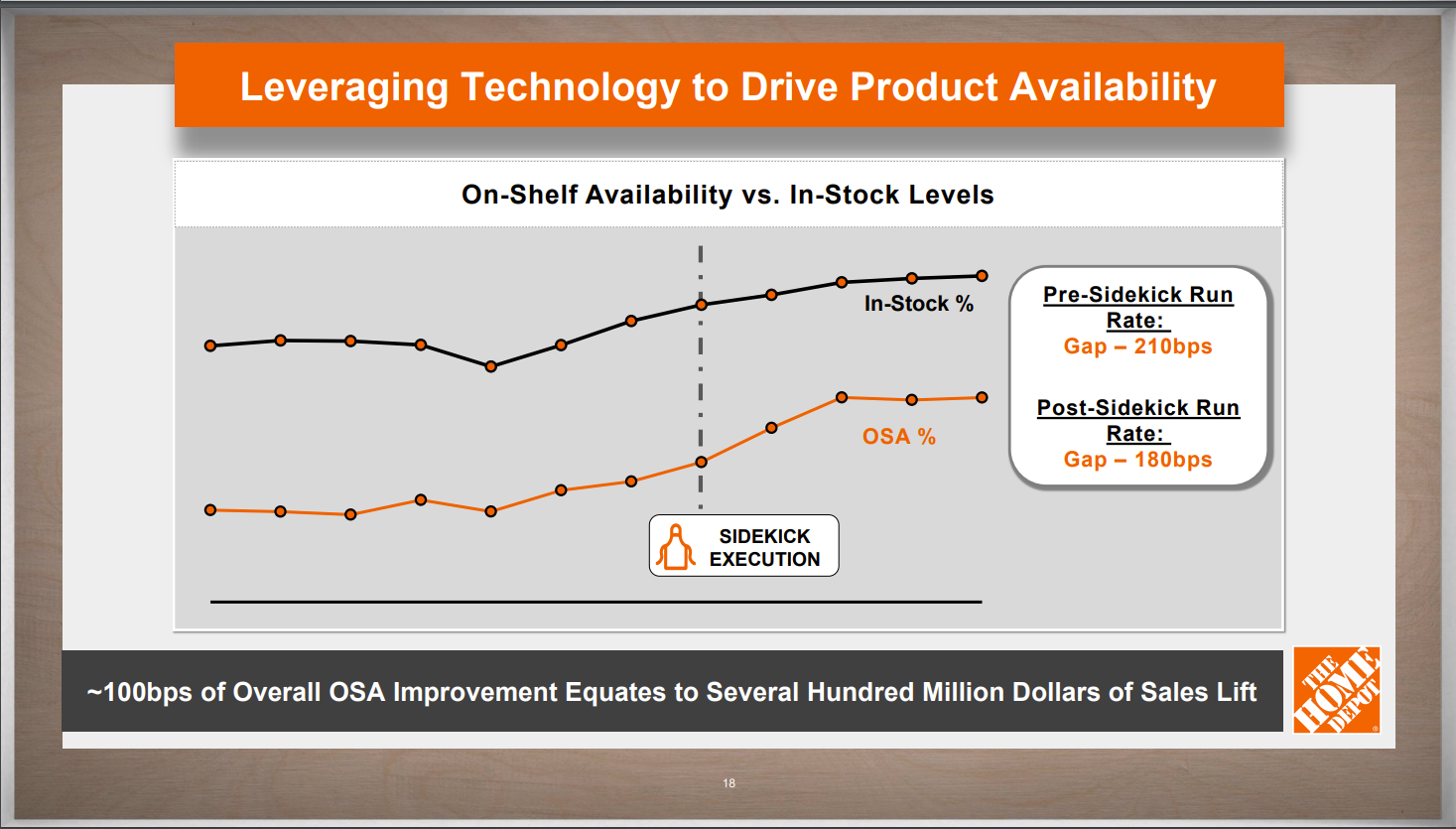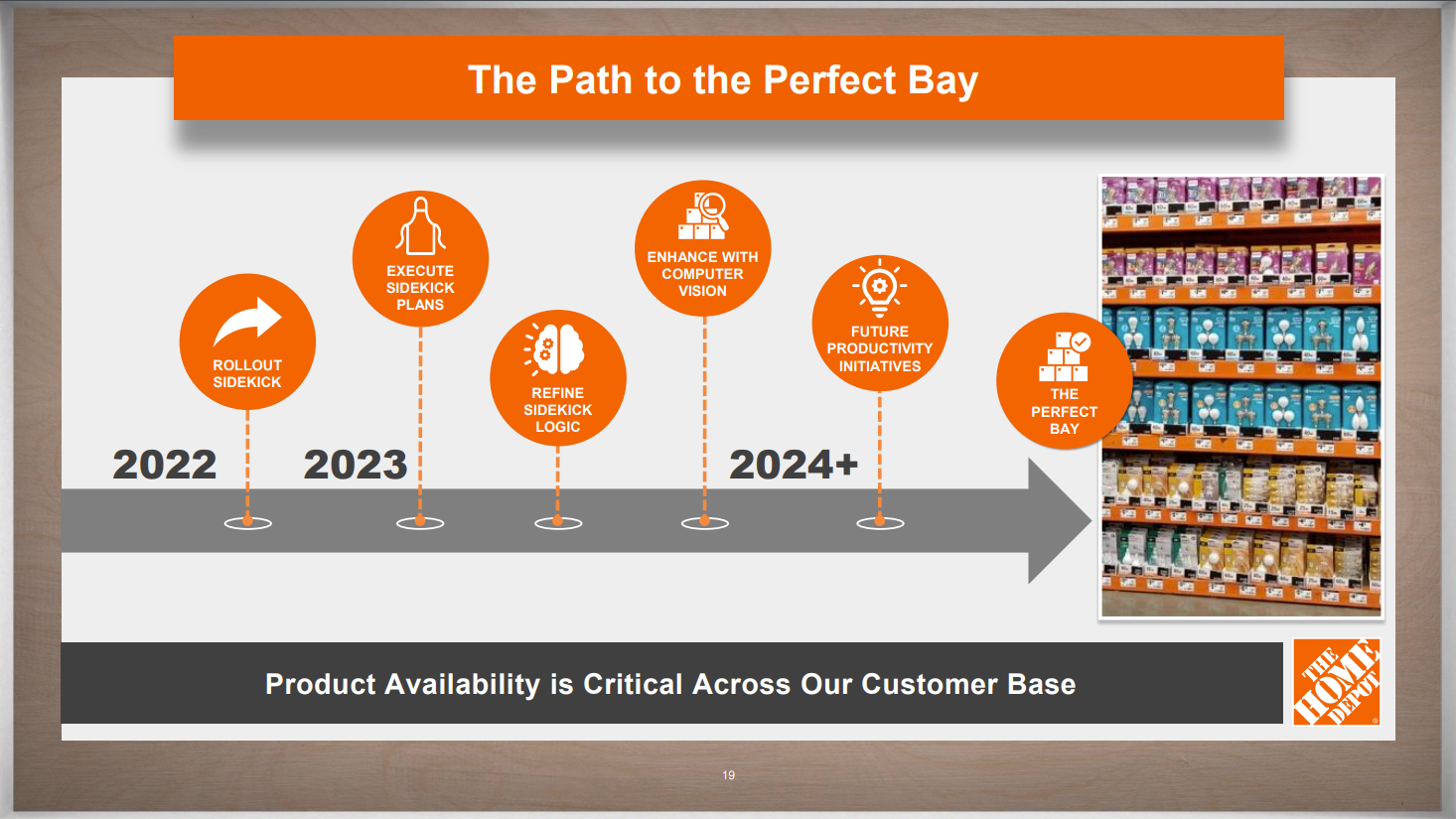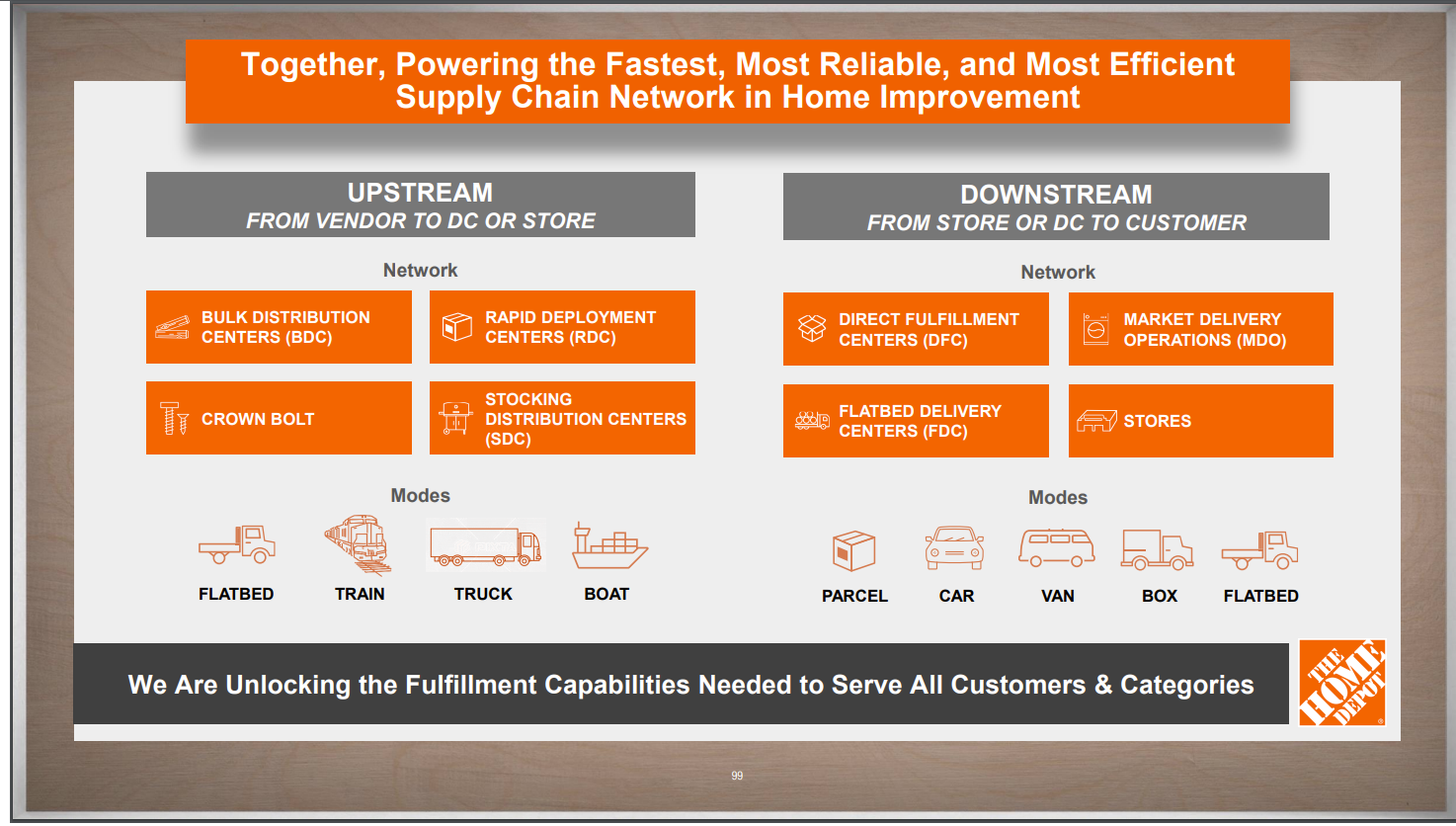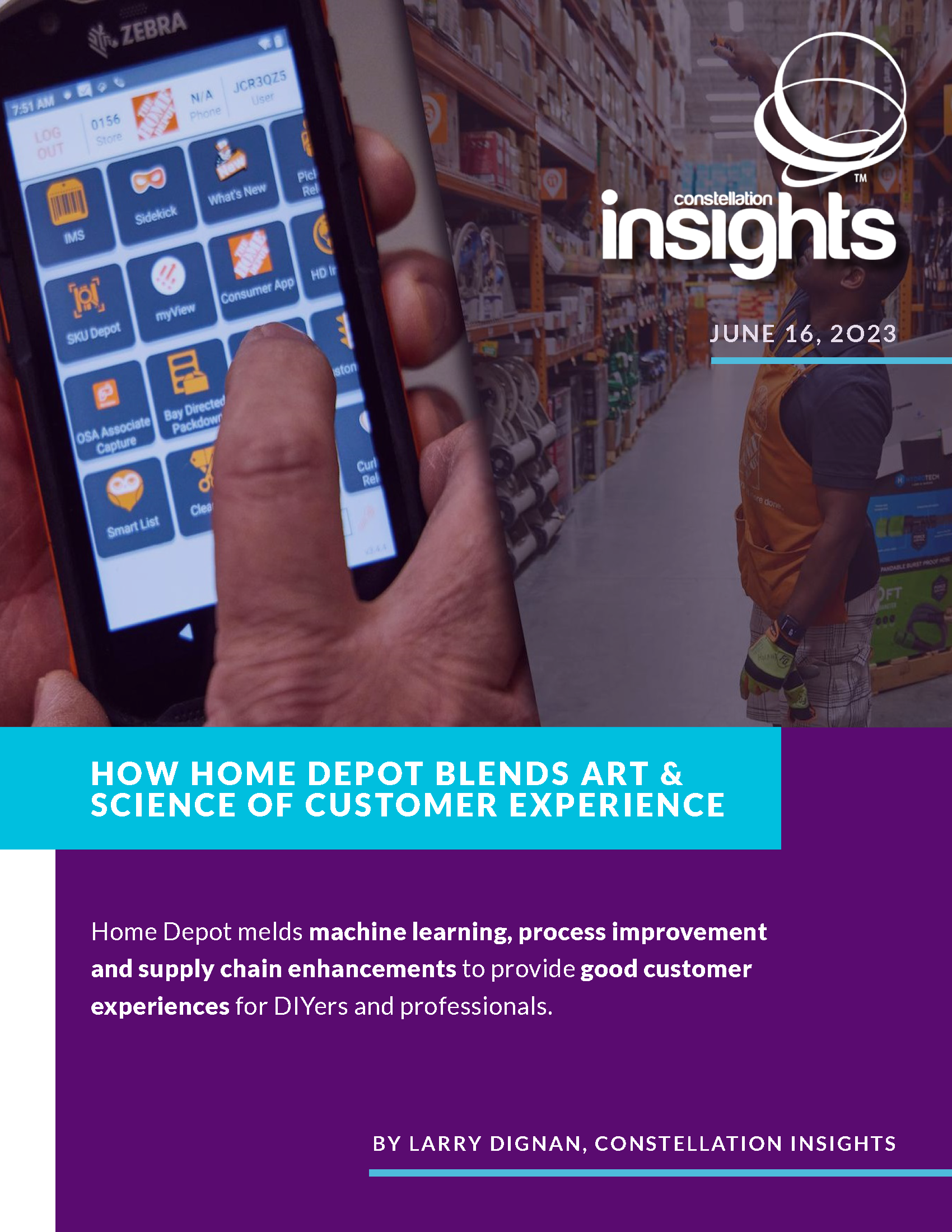Home Depot has transformed customer experiences with multiple technology and productivity projects that touch the supply chain, retail stores and associates working the floor, but few have delivered the quick returns of Sidekick.
At Home Depot's Investor Day, Ann-Marie Campbell, Executive Vice President, U.S. Stores and International Operations, walked through Home Depot's roadmap for its Sidekick app and devices that have transformed customer experiences. Sidekick is just one example of how Home Depot is balancing the art and science of home improvement retail.
Sidekick is an app that enables associates to prioritize sales and restocking tasks via hdPhones, a Zebra device that's used on the store floor. Sidekick, which was rolled out with Home Depot partners, Zebra Technologies, HPE and Aruba, an HPE unit, includes:
- Machine learning and algorithms that determine what tasks are actionable.
- Machine vision to detect and fill out-of-stock products.
- Alerts to specific associates to prioritize tasks.
- A dashboard to show when tasks are completed and how to.
- Integration with other platforms.
At the beginning of 2023, Home Depot said it rolled out more than 99,000 devices. Campbell said the returns have been strong.
"We're continuously investing in new processes, capabilities and technology, and we have a multitude of initiatives we're working on to drive further productivity and sales," said Campbell.
Campbell added that the machine learning behind Sidekick directs associates to bays where on-shelf availability is low or depleted. "The beauty of this machine learning model is that the algorithm is continuously learning as tasks are completed and will continue to get better and better at directing our associates to the right bay at the right time," said Campbell.
Home Depot is trying to narrow the gap between in stock goods and on-shelf availability. The idea is to ensure that a hot product is available to buy right away. If Home Depot improves on-shelf availability (OSA) by about 100 basis points it receives a sales lift of several hundred millions of dollars.

Campbell said Sidekick is the first step in "the journey to achieve the perfect bay for our customers. According to Campbell, the next step is to roll out computer vision in its stores.
She explained:
"Computer Vision will enable technology to do what we previously relied on Associate Eyes to do. To start with, the Associates will take a picture of Bays and Overheads with their hdPhones, which will feed into our system and provide a real time view of inventory, similar to the way our Overhead management system help us easily locate palletized products stored in our Overheads. Computer Vision will give us better visibility into product that is on our shelves and in the space between our shelves and Overhead, which will further improve OSA position and drive sales. We know that our associates are a key differentiator for us, and they are essential in delivering the customer experience we strive for. In order to provide the best customer experience in home improvement, we must focus on cultivating the best Associate experience in retail."

Home Depot's big picture: The art and science of retailing
Home Depot CEO Ted Decker said the company's priorities are to grow its consumer and professional businesses, create differentiated experiences and drive financial performance with productivity and sales gains.
"We will continue to invest in growth and leverage our scale to drive productivity, and extend our low-cost provider position," said Decker. "Our enhanced capabilities across the business position us to pursue opportunities we could not meaningfully address in the past, which provide significant growth opportunities with both DIY and Pro customers."
Also see:
The 2023 Home Depot Investor Day had a different feel than previous events. This year's meeting with analysts featured a lot of technology and process improvement opportunities, but IT was woven throughout business units. In previous years, say 2017, Home Depot gave technology operations its own section in presentations. Today, Home Depot is digital with data, process improvement and technology in every part of the business.
One thing is clear: Home Depot's technology investments paid off nicely despite the COVID-19 pandemic, an economy that resembled a roller coaster and shifting consumer behaviors. From 2019 to 2022, Home Depot delivered grew sales by more than $47 billion and grew earnings per share more than 60%.
Billy Bastek, Executive Vice President, Merchandising at Home Depot, referred to the balancing act at as the art and science of retail.
Here's how Bastek outlined the science:
"One of the most significant benefits of this is our ability to localize our products to meet market demands and our ability has never been better. Our enhanced data science capabilities, improved space optimization, and planogram tools help ensure we have the right products in front of our customers every day. This is the science."
The art is having an eye for strong products and merchants who are authorities in their categories. "Our merchants are the customers who advocate for value, and they select the best products and curate the right assortments in our stores and online. This is the art," said Bastek.
Bastek added that Home Depot wants to be a place--digital and physical--where partners can launch new innovative products, save customers time and display powerful brands as well as private-label goods. Sixty percent of Home Depot's customer base shop online and physical channels via an "interconnected experience."
Home Depot has come a long way with its interconnected experience, but Bastek acknowledged gaps including simplifying order communications, differentiated merchandise bundles and visualization tools for large projects.
To focus on improving those customer experiences, Home Depot added an Executive Vice President of Customer Experience, Matt Carey. Carey said the goal is to create a feedback loop between customers, associates, project managers, data scientists and business analysts focused on one thing: Making it easier for customers to shop.
Carey said:
"Customers are no longer accepting friction. They expect the same ease and simplicity that they experience when they shop or engage with their favorite streaming service, rideshare or travel partner. Creating a simple and easy to use experience is really pretty hard, especially against a backdrop that is constantly changing and in a business as complex as home improvement. It is our job to reduce the complexity for our customers."
Orchestration, order management and Home Depot's supply chain
Historically, supply chain was considered separate from customer experience. Today, logistics, delivery and efficiency can make or break a customer's experience. And given Home Depot's biggest growth market is professional contractors, the orchestration of the supply chain and order management is everything.
According to Chip Devine, Senior Vice President of Outside Sales at Home Depot, professional contractors work with more than 10 suppliers to get products for a single job. These suppliers range from lumber suppliers to specialty paint retailers to flooring, HVAC, electrical and kitchen and bath suppliers.
Home Depot's plan is to consolidate those suppliers with its ecosystem. "Over the last several years, we've been building an ecosystem that can deliver a differentiated end-to-end experience. The importance of this ecosystem is that it all works together to deliver a value proposition," said Devine.
Devine noted that Home Depot's systems were built to service immediate needs of a professional, but orchestration of orders is just as important. Devine said: "we're investing in future technology and infrastructure that will help us more easily manage orders in advance, reserve inventory, schedule and build deliveries based on a project schedule which is very different than our current cash and carry model."
To become a one-stop shop for professionals, Home Depot will need to schedule lumber for one day, roofing two weeks later and deliver products to multiple addresses. Trade credits will be another key item so professionals can manage their cash flow.
Enter Home Depot's supply chain scale. Home Depot has been investing in its supply chain for years and set out in 2017 to become the fastest, most efficient and most reliable supply chain in home improvement.

John Deaton, Executive Vice President of Supply Chain and Product Development at Home Depot, highlighted the scale of the retailer. Home Depot's supply chain handles more than 15,000 inbound truckloads, delivers more than 60 million parcels annually and manages more than 10 million big and bulky deliveries a year.
A few supply chain highlights:
- Home Depot has automated its rapid deployment centers to require fewer product touches.
- Bulk distribution centers have been expanded in volume.
- Home Depot has opened more than 100 new facilities with enhanced fulfillment capabilities.
- The retailer has added flatbed delivery centers for professionals.
- Took over appliance delivery from third party networks.
"Many of our nodes of our supply chain network also alleviate fulfillment pressure in our stores which allows our associates to spend more time driving a better customer experience for our customers while also driving productivity," said Deaton.
Going forward, Home Depot's Deaton said downstream supply chain operations will be refined with robotics, better forecasting and enhanced labor management processes. "While we have made a lot of progress, our work to enhance the customer experience is never done," he said.
Select Home Depot vendors
- Google Cloud
- HPE/Aruba
- SAP
- ServiceNow
- UIPath
- Zebra Technologies
Sources:
SeekingAlpha: Home Depot Investor Conference transcript
Home Depot: Investor Conference presentations
Google Cloud blog: The Home Depot orchestrates self-service cloud solutions with Workflows
How The Home Depot helps doers get more done with SAP and Google Cloud
__



